 Edit article
Edit articleSeries
The History of Iron in Ancient Israel

Reuven Anati, the Blacksmith, by Flavio~, Flicker, CC BY 2.0
Six metals were commonly used in the Bronze and Iron ages.[1] All of these are mentioned in the story of Israel’s war against the Midianites in Numbers. After the Israelites win the war, they take a large amount of booty, including metals, which need to be purified:
במדבר לא:כב אַךְ אֶת הַזָּהָב וְאֶת הַכָּסֶף אֶת הַנְּחֹשֶׁת אֶת הַבַּרְזֶל אֶת הַבְּדִיל וְאֶת הָעֹפָרֶת. לא:כג כָּל דָּבָר אֲשֶׁר יָבֹא בָאֵשׁ תַּעֲבִירוּ בָאֵשׁ וְטָהֵר...
Num 31:22 Gold and silver, copper, iron, tin, and lead— 31:23 any article that can withstand fire—these you shall pass through fire and they shall be clean…[2]
This booty list aligns with the biblical tradition that associates the origins of metallurgy with the proto-Arabian peoples such as the Midianites. A different proto-Arabian tribe,[3] the Kenites, occupies the central role in these traditions. Specifically, one of the Kenite ancestors, Tubal-Cain, in an account of the earliest period of human history, is described as the inventor of metallurgy:
בראשׁית ד:כב וְצִלָּה גַם־הִוא יָלְדָה אֶת־תּוּבַל קַיִן לֹטֵשׁ כָּל־חֹרֵשׁ נְחֹשֶׁת וּבַרְזֶל...
Gen 4:22 As for Zillah, she bore Tubal-cain, who forged all implements of copper (or bronze)[4] and iron.[5]
Indeed, scholars associate the biblical Kenites and/or Midianites with the Qurraya culture,[6] whose archaeological remains, including pottery from northwest Arabia (“Qurraya ware”), have been found in the two main Arabah copper mining regions of Timna and Feynan. Although the Bible’s references to proto-Arabian metallurgy is set in the second and first millennia B.C.E. reality, the story of the introduction of metal usage begins much earlier than this.
Native Metals and Metal Ores
Gold, silver, and copper can occur geologically in metallic form, in what is called “native metals,” but these occurrences are rare. In general, metals are found in mineral form, known as “ores,” in which the base metal is bound to other elements, such as oxygen, carbon, or sulfur. Isolating the metal requires smelting, which uses charcoal fire to separate the metal from the other elements in its ore.
Following a long period of use of copper in its native form, copper smelting was discovered and practiced by the 5th millennium B.C.E., over wide geographical areas, from Iran to Iberia. By the 4th millennium, silver and gold, which occur in minute quantities in lead ores, were being separated from the lead.[7] Beginning in the mid-3rd millennium, tin was added to copper to produce bronze, a metal alloy with qualities superior to unalloyed copper, including increased hardness, lower melting temperatures, and an attractive golden tint.[8]
A certain paradox lies in the fact that iron is the most abundant metal in the earth’s crust, and yet it was the last of these six metals to have been introduced into common use.
Smelting Iron
For millennia, iron was produced in minute quantities and treated as a prestige metal. Its earliest appearance in the ancient Near East may have derived from the use of meteorites. Iron cannot be smelted in the same way as other metal ores, because of its relatively high melting point, over 1500°C.
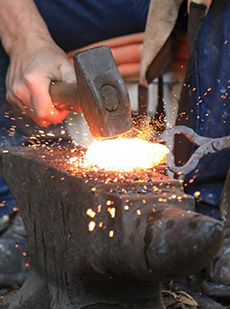
Lowering this temperature requires the use of a large amount of charcoal which introduces carbon into the metal. While a small amount of carbon in the metal (up to 2%) would be favorable, creating steel (an alloy of iron and carbon), a large amount would produce a brittle unworkable metal. (The practice of decarburizing the iron, i.e., removing the excess carbon from the iron metal, was unknown until this time.)
Eventually, ancient smiths developed a method to produce usable iron, smelting the iron ore in a furnace with charcoal at 1200°C. At this temperature iron was not liquefied, but appeared in a spongy mass, called a “bloom,” together with “slag,” a mixture of impurities produced as a by-product of smelting. Metal smiths would remove the slag from the bloom manually by hammering the mass.
Deutero-Isaiah describes the immense effort required to produce usable iron by this method:
ישׁעיה מד:יב חָרַשׁ בַּרְזֶל מַעֲצָד
וּפָעַל בַּפֶּחָם
וּבַמַּקָּבוֹת יִצְּרֵהוּ
וַיִּפְעָלֵהוּ בִּזְרוֹעַ כֹּחוֹ
גַּם־רָעֵב וְאֵין כֹּחַ
לֹא־שָׁתָה מַיִם וַיִּיעָף.
Isa 44:12 The craftsman in iron, with his tools,
Works it over charcoal
And fashions it by hammering,
Working with the strength of his arm.
Should he go hungry, his strength would ebb;
Should he drink no water, he would grow faint.
Not all the slag could be extracted through this method, so the resulting product was iron metal with some slag inclusions, and usually contained small amounts of carbon, thus creating a “natural” steel, which was then forged into shape while red hot. This method, known as the “bloomery process,” was used until the industrial revolution.
The Origins of Iron Smelting
It is unknown where iron was first smelted, and scholars have offered theories about how the process spread to the Levant.
A Closely Guarded Philistine Secret?
At one time, biblical scholarship assumed that the Philistines introduced iron technology into the region. The theory was based on a passage from 1 Samuel that claims that the Philistines controlled the iron in the region:
שׁמואל א יג:יט וְחָרָשׁ לֹא יִמָּצֵא בְּכֹל אֶרֶץ יִשְׂרָאֵל כִּי־אָמְרֻ פְלִשְׁתִּים פֶּן יַעֲשׂוּ הָעִבְרִים חֶרֶב אוֹ חֲנִית. יג:כ וַיֵּרְדוּ כָל־יִשְׂרָאֵל הַפְּלִשְׁתִּים לִלְטוֹשׁ אִישׁ אֶת־מַחֲרַשְׁתּוֹ וְאֶת־אֵתוֹ וְאֶת־קַרְדֻּמּוֹ וְאֵת מַחֲרֵשָׁתוֹ... יג:כב וְהָיָה בְּיוֹם מִלְחֶמֶת וְלֹא נִמְצָא חֶרֶב וַחֲנִית בְּיַד כָּל־הָעָם אֲשֶׁר אֶת־שָׁאוּל וְאֶת־יוֹנָתָן וַתִּמָּצֵא לְשָׁאוּל וּלְיוֹנָתָן בְּנוֹ.
1 Sam 13:19 No smith was to be found in all the land of Israel, for the Philistines were afraid that the Hebrews would make swords or spears. 13:20 So all the Israelites had to go down to the Philistines to have their plowshares, their mattocks, axes, and colters sharpened…. 13:22 Thus on the day of the battle, no sword or spear was to be found in the possession of any of the troops with Saul and Jonathan; only Saul and Jonathan had them.
Although the passage does not name iron specifically, the reference to the plough (machareshah) suggests that it is referring to iron. Before iron became widely used, tools such as ploughs were made of wood, not bronze, so a smith would not have been needed to sharpen the blade.
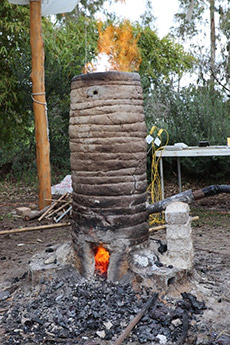
Some scholars took this passage to mean that the Philistines understood how to smelt iron but withheld that knowledge from the Israelites to maintain a military advantage over them.[9] But the archaeological data contradicts this picture. Very few utilitarian objects made from iron are known from Philistia (and elsewhere in the region) during the 12th–11th centuries B.C.E. and, so far, no remains from iron production from this period have been unearthed.
Several prestigious knives with ivory handles, iron blades and bronze rivets have been found in the Philistine city of Ekron (Tel Miqne), dating to the late 12th century B.C.E. These finds were originally used to substantiate the assumed Philistine monopoly, but further study has indicated that they were likely imported from Cyprus. Moreover, the Philistines originated in the Aegean and/or western Anatolia (modern Turkey), but iron technology there lagged behind the Near East, so it cannot be something that they brought with them into the region.
A Closely Guarded Hittite Secret?
Anatolia, by far, has yielded the greatest amount of textual evidence for early iron smelting, mainly from the 2nd millennium B.C.E., suggesting that iron technology originated with the Hittites, a kingdom in central Anatolia from the early 2nd millennium B.C.E.[10] This is supported by the fact that the earliest datable iron production remains, dated to the 12th century B.C.E., were found in the Neo-Hittite site of Carchemish (Tell Tayinat), originally part of the Hittite Empire.
An old theory, no longer accepted, suggested that the Hittites kept the bloomery process as a closely guarded secret, and only after the demise of the kingdom in the 12th century, at the end of the Late Bronze Age, did the technological know-how spread to the rest of the Near East. The gradually increasing number of iron objects from around the mid-2nd millennium found in the Near East—each unique and prestigious—suggests that the technology was beginning to spread several centuries prior to the fall of the Hittites.
As for the southern Levant, iron use was introduced here gradually after the fall of the Hittite empire, during the 12th–11th centuries B.C.E. What do we know about the beginnings of iron use in this region?
The Introduction of Iron into the Southern Levant
In one of the poetic descriptions of the land, Deuteronomy describes Israel as abundant in copper and iron:
דברים ח:ט ... אֶרֶץ אֲשֶׁר אֲבָנֶיהָ בַרְזֶל וּמֵהֲרָרֶיהָ תַּחְצֹב נְחֹשֶׁת.
Deut 8:9 …A land whose rocks are iron and from whose hills you can mine copper.[11]
The blessing of the tribes in Deuteronomy mentions Asher[12] in association with both of these metals:
דברים לג:כד וּלְאָשֵׁר אָמַר
בָּרוּךְ מִבָּנִים אָשֵׁר
יְהִי רְצוּי אֶחָיו
וְטֹבֵל בַּשֶּׁמֶן רַגְלוֹ.
לג:כה בַּרְזֶל וּנְחֹשֶׁת מִנְעָלֶיךָ
וּכְיָמֶיךָ דָּבְאֶךָ.
Deut 33:24 And of Asher he said:
Most blessed of sons be Asher;
May he be the favorite of his brothers,
May he dip his foot in oil.
33:25 May your doorbolts be iron and copper,
And your security last all your days.
Of the six metals mentioned in Numbers 33, only these two, copper and iron, were found in the land of Israel. Gold was probably brought from the eastern desert of Egypt, while silver, lead and tin were imported, beginning at the end of the Late Bronze Age (c. 13th century), from the western Mediterranean. Copper was systematically produced in the Arabah (see below), while iron was more ubiquitous.
The problem is that not all iron deposits are useful. Only rich iron ores were suitable for smelting in the bloomery process.[13] Such rich ores, containing up to 80% of pure iron (Fe), were formed in hydrothermal processes and found in faults mainly across the Negev and in the Ajlun in Jordan (biblical Gilead), not far from Amman.
Transjordan
In the Transjordan, burials dated to the early 12th century contain dozens of steel bracelets.[14] As the burials were distributed in the proximity of the rich iron deposit of Mugaret al Warda near Amman, they were probably locally produced, thus providing us with evidence for the initial introduction of this technology in the region.
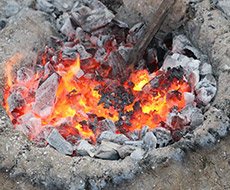
The site of Mugarat Al-Warda in the Ajlun, near Amman, biblical רַבַּת בְּנֵי עַמּוֹן (Rabbah of Ammon), is the only iron deposit with evidence for Iron Age exploitation; smelting remains are found in its vicinity.[15] These were dated using Carbon 14 to c. 900 B.C.E.
Several biblical references may allude to the awareness of a rich iron source in the Gilead.[16] Og the giant king of the Bashan is described as sleeping on a bed of iron, which is to be found in Rabbah of Ammon:
דברים ג:יא כִּי רַק־עוֹג מֶלֶךְ הַבָּשָׁן נִשְׁאַר מִיֶּתֶר הָרְפָאִים הִנֵּה עַרְשׂוֹ עֶרֶשׂ בַּרְזֶל הֲלֹה הִוא בְּרַבַּת בְּנֵי עַמּוֹן תֵּשַׁע אַמּוֹת אָרְךָּהּ וְאַרְבַּע אַמּוֹת רָחְבָּהּ בְּאַמַּת־אִישׁ.
Deut 3:11 Only King Og of Bashan was left of the remaining Rephaim. His bedstead, an iron bedstead, is now in Rabbah of the Ammonites; it is nine cubits long and four cubits wide, by the standard cubit!
In addition, David inflicts a punishment on the Ammonites that, according to Yehuda Kiel (1916–2011), involved enslavement in iron mines:[17]
שׁמואל ב יב:לא וְאֶת־הָעָם אֲשֶׁר־בָּהּ הוֹצִיא וַיָּשֶׂם בַּמְּגֵרָה וּבַחֲרִצֵי הַבַּרְזֶל וּבְמַגְזְרֹת הַבַּרְזֶל וְהֶעֱבִיר אוֹתָם בַּמַּלְבֵּן וְכֵן יַעֲשֶׂה לְכֹל עָרֵי בְנֵי־עַמּוֹן וַיָּשָׁב דָּוִד וְכָל־הָעָם יְרוּשָׁלִָם.
2 Sam 12:31 He led out the people who lived there and set them to work with saws, iron threshing boards, and iron axes, or assigned them to brickmaking; David did this to all the towns of Ammon. Then David and all the troops returned to Jerusalem.
Finally, 2 Samuel 19 ties the Gilead to iron through the name of one very wealthy individual from this region, בַּרְזִלַּי, meaning “Iron Guy”:
שׁמואל ב יט:לב וּבַרְזִלַּי הַגִּלְעָדִי יָרַד מֵרֹגְלִים וַיַּעֲבֹר אֶת־הַמֶּלֶךְ הַיַּרְדֵּן לְשַׁלְּחוֹ אֶת־בַּיַּרְדֵּן. יט:לג וּבַרְזִלַּי זָקֵן מְאֹד בֶּן־שְׁמֹנִים שָׁנָה וְהוּא־כִלְכַּל אֶת־הַמֶּלֶךְ בְּשִׁיבָתוֹ בְמַחֲנַיִם כִּי־אִישׁ גָּדוֹל הוּא מְאֹד.
2 Sam 19:32 Barzillai the Gileadite had come down from Rogelin and passed on to the Jordan with the king, to see him off at the Jordan. 19:33 Barzillai was very old, eighty years of age; and he had provided the king with food during his stay at Mahanaim, for he was a very wealthy man.
Thus, the Bible seems to associate iron with the Transjordan.
Cyprus
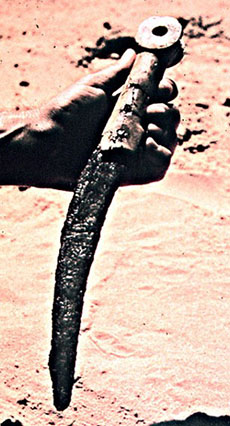
Another source of iron in this period was Cyprus, where hundreds of iron knives were found dating to the 12th–11th centuries B.C.E.[18] As mentioned above for Philistia, several elaborately designed knives appear in the southern Levant in this period.
The outward appearance of these knives does not indicate whether they were of Cypriot origin or Levantine imitations. Analyses of the bronze rivets, however, determined that in some cases, the copper derived from the Arabah, rather than from Cyprus, indicating locally made knives. Thus, the appearance of iron knives in the Levant began with knives of this style being imported and subsequently imitated by local smiths.
The Iron Age I—Mostly Bronze
A count of tools and weapons from 11th century B.C.E. archaeological contexts, typically considered to be in the early Iron Age, shows that over 90% were made of bronze. In fact, the limited use of iron during this time, particularly for utilitarian purposes, indicates that during the 12th–11th centuries B.C.E., the full-blown Iron Age had not yet begun—not in the Levant or anywhere else.[19] This suggests that the biblical claim that the Canaanites had iron chariots during the period of the judges is problematic.
Canaanite Chariots of Iron
In Joshua 17:16, the Josephites express concern about their ability to conquer the Canaanites in their allotted territory, because the Canaanites had iron chariots:
יהושׁע יז:טז וַיֹּאמְרוּ בְּנֵי יוֹסֵף לֹא־יִמָּצֵא לָנוּ הָהָר וְרֶכֶב בַּרְזֶל בְּכָל־הַכְּנַעֲנִי הַיֹּשֵׁב בְּאֶרֶץ־הָעֵמֶק לַאֲשֶׁר בְּבֵית־שְׁאָן וּבְנוֹתֶיהָ וְלַאֲשֶׁר בְּעֵמֶק יִזְרְעֶאל.
Josh 17:16 The Josephites said: “The hill country is not enough for us, and all the Canaanites who live in the valley area have iron chariots, both those in Beth-shean and its dependencies and those in the Valley of Jezreel.”[20]
We hear more about these iron chariots in the opening chapter of Judges:
שופטים א:יט וַיְהִי יְ־הוָה אֶת יְהוּדָה וַיֹּרֶשׁ אֶת הָהָר כִּי לֹא לְהוֹרִישׁ אֶת יֹשְׁבֵי הָעֵמֶק כִּי רֶכֶב בַּרְזֶל לָהֶם.
Judg 1:19 YHWH was with Judah, so that they took possession of the hill country; but they were not able to dispossess the inhabitants of the plain, for they had iron chariots.
Nine hundred such iron chariots feature in the battle of Israel against the Canaanite general Sisera in the Deborah story:
שופטים ד:ג וַיִּצְעֲקוּ בְנֵי יִשְׂרָאֵל אֶל יְ־הוָה כִּי תְּשַׁע מֵאוֹת רֶכֶב בַּרְזֶל לוֹ...
Judg 4:3 The Israelites cried out to YHWH; for he had nine hundred iron chariots…[21]
Iron chariots did not exist in the Iron Age at all, certainly not in the Iron I, when these stories are set, where barely any iron was used at all.
The military “light chariot” was introduced during the early 2nd millennium B.C.E. when spoked wheels were invented. (Earlier wheels were solid circles and thus quite heavy.) As weight was critical for the speed of the chariot in war, this vehicle would have been made of wood rather than metal.
Various Bronze Age representations of chariots and descriptions in texts corroborate this. Chariots were not made of metal in the Bronze or Iron Ages. How then should we understand the “chariots of iron” mentioned in Joshua and Judges?
Scholars have proposed different explanations for these iron chariots:[22]
1. Iron Nails and Brackets
Some scholars suggest that the different chariot parts made of wood would have been held together using iron nails and brackets. This, however, is highly unlikely, given that iron was scarce even in the early Iron Age, and reserved for prestigious use; it would not have been used for rivets. In addition, such rivets are unknown prior to the 1st millennium. Finally, they would not be visible, and thus do not justify the name “iron chariots.”
2. Plated or Fitted with Iron
Another suggestion is that the chariots were plated with iron, but this is untenable. Iron plates would have placed unnecessary weight on the chariots and would have required a considerable amount of iron that was not yet available at the time. Moreover, the use of iron for plating is unknown throughout the Iron Age. The only chariot fittings ever found in archaeological excavations were, in fact, all made of bronze.[23]
3. Iron Weaponry
Another suggestion is that the wooden chariots were equipped with iron weaponry, but this too is untenable. Iron weapons are unknown prior to the 1st millennium B.C.E.
4. Anachronism
The biblical narrative is anachronistic and refers to chariots that existed at the time of writing, during the 1st millennium B.C.E. However, after the Bronze Age (12th century B.C.E. and on), the use of war chariots generally declined. The Assyrians used chariots only to carry equipment and wounded soldiers or occasionally officials, but not for battle. Iron was probably used in the construction of these chariots and it is possible that knowledge of these chariots inspired the biblical imagination about Canaanite chariots. Alternatively, during the Persian period, iron was incorporated in scythed war chariots (with blades mounted on their sides), and these may have inspired the biblical picture of Canaanite chariots.
5. Symbolic
The more compelling explanation is that “chariots of iron” may mean strong chariots since iron (in fact steel) was perceived as stronger than bronze. Iron, in this case, would be a symbolic expression of strength, an image well-known in the Iron Age, rather than an accurate description of the actual chariots used by the Canaanites in the Late Bronze and Iron I.
The Iron Age II—Iron Begins to Take Off
The 10th–9th centuries B.C.E. saw a major change in the use of metals in agricultural and fighting implements: tools and weapons were mostly made of iron. That this process was well underway already in the early 10th century is apparent from the site of Khirbet Qeiyafa, located in the Shephelah region, where iron was used to produce sickle blades for agricultural use.[24]
We do not know whether all stages of iron production—including smelting the iron from its ores and smithing a bar (ingot) or a bloom—or just some of them, were performed in the Israelite urban centers.[25]

The shift to the use of iron in the southern Levant in this period is indicated by a sharp rise in the number of iron objects in relation to bronze, as well as by the appearance of widespread evidence of ironworking. Iron became the metal of choice for the production of tools and weapons. The prohibition against iron tools in the building of altars in Deuteronomy (cf. 1 Kgs 6:7) may reflect this reality:
דברים כז:ה וּבָנִיתָ שָּׁם מִזְבֵּחַ לַי־הוָה אֱלֹהֶיךָ מִזְבַּח אֲבָנִים לֹא־תָנִיף עֲלֵיהֶם בַּרְזֶל.
Deut 27:5 There, too, you shall build an altar to YHWH your God, an altar of stones. Do not wield an iron tool over them.
The marked transition to the use of iron thus occurred during the 10th century B.C.E., with a surge in production during the time of the rising kingdoms of Judah, Israel, and their neighbors.
In order to produce a metal truly superior to bronze, the amount of carbon introduced into the iron would need to be controlled and the red-hot metal would need to be quenched, i.e. immersed when red-hot into liquid – an action which changes the microstructure of the metal and renders it much stronger. However, the choice of iron for the production of tools and weapons came long before the consequences of these actions were appreciated.[26]
While some biblical texts as in the case of the “iron chariots” presented above, seem to view iron as the stronger metal, other texts see iron and bronze as equivalent metals, thus presenting them as parallel terms:
איוב כ:כד יִבְרַח מִנֵּשֶׁק בַּרְזֶל תַּחְלְפֵהוּ קֶשֶׁת נְחוּשָׁה.
Job 20:24 Fleeing from iron arrows, he is shot through from a bow of bronze.[27]
תהלים קז:טז כִּי־שִׁבַּר דַּלְתוֹת נְחֹשֶׁת וּבְרִיחֵי בַרְזֶל גִּדֵּעַ.
Ps 107:16 For He shattered gates of bronze, he broke their iron bars.
Give that iron does not appear to have been superior to bronze during most of the Iron Age, why did iron become so popular then?
A Shortage of Bronze
Some suggest that the move away from bronze relates to the collapse of the extensive Late Bronze Age Mediterranean trade at the end of the period, around the beginning of the 12th century B.C.E., which allegedly caused a shortage in the raw materials (copper and tin) required for the production of bronze. Yet this does not seem to be the case.
Excavations at both Timna and Faynan show that following a period of Egyptian control over limited copper production in the Bronze Age, the copper industry at both sites in the Iron Age rocketed and reached an unprecedented scale.[28] Though the possibility of tin shortage during this time is slightly more difficult to assess, analysis of bronze objects from the 12th–11th centuries in the southern Levant and beyond does not show reduced tin concentrations, which would have been indicative of a shortage.
More importantly, the limited use of iron during this time, particularly for utilitarian purposes, indicates that during the 12th–11th centuries B.C.E., the full-blown Iron Age had not yet begun.[29] Thus, we have neither evidence of a shortage of copper or tin, nor evidence of an increase in iron usage during this period, to support the theory that a shortage of bronze caused the switch to iron.
Adoption of New Technology
An innovative suggestion is that experienced bronzesmiths may have been the ones to adopt the new technology. As bronze can be easily melted and cast into shape, smiths began to reserve bronze for the production of jewelry and other elaborate objects (as we see in the biblical description of ritual objects),[30] while turning to forged iron for utilitarian purposes.
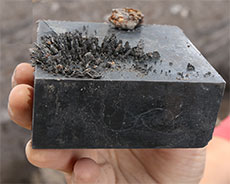
Evidence from smithies in the region supports this theory.[31] (None predate the 10th century B.C.E.) The remains include “slag cakes,” brownish conglomerates that accumulate at the bottom of both smelting furnaces and smithing hearths, as well as “hammerscales,” which are tiny particles that flake off an iron object during forging that can only be collected by using a magnet.
The system used to inflate air into the furnace/hearth also commonly leaves behind tangible remains: The very end of the reed pipe leading from the bellows (made of perishable material at this time) to the furnace or hearth was covered with a clay tip, called a “tuyere.” The tuyere type associated closely with iron production remains is straight and square in cross-section, very different in shape from the 2nd millennium B.C.E. Canaanite tuyere used in bronzeworking, which was bent at the tip and rounded in cross-section.
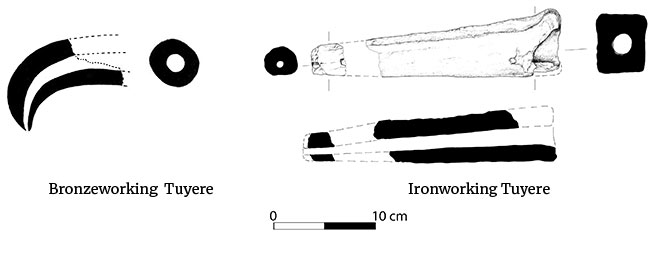
Both types were found in the same metalworking contexts, together with production remains of both bronze and iron, and often in the part of the site where bronzeworking was traditionally practiced. This indicates an intimate connection between the two metals and suggests that perhaps the same craftspeople were involved in the production of both.
Iron in Israel and Judah
Why was iron adopted by the kings of Israel and Judah and preferred over bronze? The answer is related to economic, political and social aspects during this time. Mining the copper necessary to produce bronze items was a complex procedure that was tightly controlled by its producers. Tin, the other material required for the production of bronze, was pricey. Thus, bronze was reserved for specific artefacts that required casting.
Iron, was more readily mined and available in territories that came under the control of the Israelites and Judahites, such as the Negev in the south and the Ajlun in the northeast. Its alloying component—carbon—was naturally present in the furnace and just needed to be controlled.
Thus, once iron technology was mastered, it became the cheaper, more readily available and controllable metal, and thus preferred by producers, and consequently by consumers, alike. This afforded the rulers of the kingdoms an economic asset whose control granted them enhanced political power and social standing.
TheTorah.com is a 501(c)(3) nonprofit organization.
We rely on the support of readers like you. Please support us.
Published
July 29, 2021
|
Last Updated
December 25, 2025
Previous in the Series
Next in the Series
Before you continue...
Thank you to all our readers who offered their year-end support.
Please help TheTorah.com get off to a strong start in 2025.
Footnotes

Dr. Naama Yahalom-Mack is a senior lecturer of Bronze and Iron Age archaeology at the Institute of Archaeology at The Hebrew University of Jerusalem and is head of the Institute’s Laboratory for Archaeological Materials and Ancient Technologies. She holds a Ph.D. in Archaeology from the Hebrew University, and wrote on Bronze in the Beginning of the Iron Age in the Land of Israel. Yahalom-Mack is currently co-director of the Tel Abel Beth Maacah excavations in the Hula Valley. Her research focuses on archaeometallurgy and on the provenancing of archaeological materials as a proxy for reconstructing ancient trade and economic interaction.
Essays on Related Topics:









